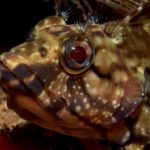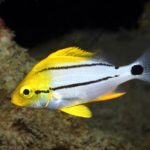The history of the Blue Heron Bridge is interesting, but not nearly as fascinating as the underwater ecosystem that thrives below it.
In the 1920s, Paris Singer, part of the sewing machine family empire, developed plans to build a $4 million resort called the Blue Heron Hotel on an isolated island off the Atlantic Coast of Florida near West Palm Beach.
In order to connect the island, which later became known as Singer Island, to the mainland, Palm Beach County built a 2700-foot-long timber and steel bridge known as the “Sherman Point Bridge” in 1925. But in 1928, a hurricane partially destroyed the bridge and it had to be rebuilt in the 1930s. In addition, a second concrete and steel two-lane drawbridge was also built in 1949 at a cost of $850,000.
As tourism grew over the years, the original low-lying wooden structure and the drawbridge could not handle the influx of traffic. A modern bridge was required and in 1974, at a cost of $8.5 million, a 4-lane, high-span bridge was built. This bridge, officially named the Jerry Thomas Memorial Bridge but known by most as the Blue Heron Bridge, crosses from the mainland to Singer Island and the eastern 350 feet of the 1949 bridge was left to become a fishing pier.
The hotel that was envisioned by Paris Singer was never built. Instead, at the foot of the bridge is a Palm Beach County park known as Phil Foster Memorial Park. It is here that we begin our underwater adventure.
The Blue Heron Bridge has become world-renowned for its astounding marine ecosystem. The support structures for the bridge have become home to a wide variety of tropical marine life and divers who explore the waters beneath the bridge can be assured of a fascinating adventure on every dive.
Entering the water directly under the bridge with a shore entry just steps from the parking lot, we swam south to an area filled with large boulders and coral outcroppings. Here we found large Cushion Sea Stars creeping along the sandy bottom in 30 feet of water, along with schools of grunts, snapper and an occasional Angelfish. Upon closer examination, though, we spied numerous interesting blennies poking their ornately adorned heads out from tiny holes and crevices. We began to fill our camera’s memory cards with interesting macro subjects. Seahorses, crabs, shrimp and tiny fish were all part of the palette of subjects.
We swam a bit further east, exploring more rocks and several small sunken boats and other debris, but decided to venture back to the bridge itself to see what we could find along its support structure.
As we approached the pilings supporting the old 1949 bridge, we found ourselves in a paradise of marine life. Schools of Spadefish shimmered by nonchalantly while Hogfish nibbled at the seaweeds growing on the cement structures. Towards the western terminus of the old bridge, we found a large Green Moral Eel hoping to find an easy meal. Along the way, we spotted large French and Grey Angels loitering beneath the bridge as well.
The protected structures beneath the bridge are an ideal nursery for breeding marine organisms. As we approached, Sergeant Major Fish defiantly defended their egg patches while juvenile Pork Fish flitted between the structures. We swam from piling to piling, stopping at each to observe and photograph the myriad marine life of this special place.
For photographers, the Blue Heron Bridge offers both macro and wide-angle imaging possibilities. With waters never reaching depths greater than 30 feet, photographers have ample time to pursue that perfect shot!
Diving the Blue Heron Bridge safely requires strict adherence to certain restrictions. Swift currents move through this area so its best to dive at high slack tide for the calmest water and the best visibility. Park rules dictate that all dives be concluded by dusk, although night dives can be arranged through local dive shops. There is an active boat channel alongside and beneath the bridge so divers must remain inside the areas where diving is permitted and must never venture beyond the limits of the boat channel.
We emerged from the water with contented smiles and overworked cameras. The Blue Heron Bridge is an ideal addition to your dive itinerary if you are in this part of Florida. For most who drive over this bridge to or from Palm Beach to Singer Island, the bridge is simply a means to an end. For divers, it is the destination!
- The Lighthouse at Jupiter Inlet stands guard over the waters of the nearby Jupiter Inlet
- The fearsome face of a Green Moray Eel
- A school of Tomtate Grunts shelter find shelter in the reef
- A Hogfish pokes around for some food
- The face of a Hairy Blenny
- Sergeant Major protecting its clutch of eggs
- A juvenile Porkfish
- Cushion Sea Stars patrol the bottom near the bridge
- A School of Atlantic Spadefish beneath the bridge
- The Blue Heron Bridge near Singer Island makes for a spectacular shore dive














